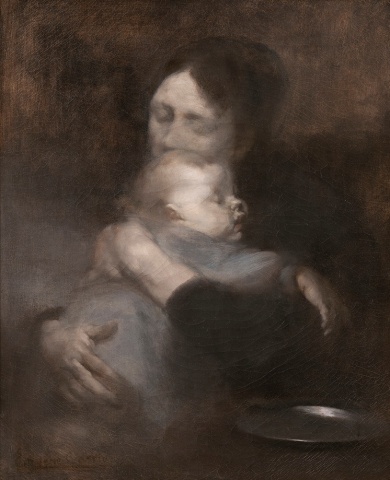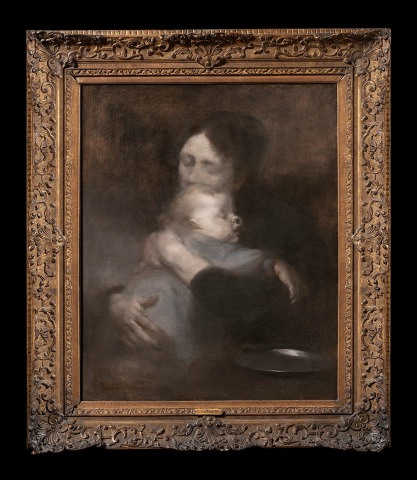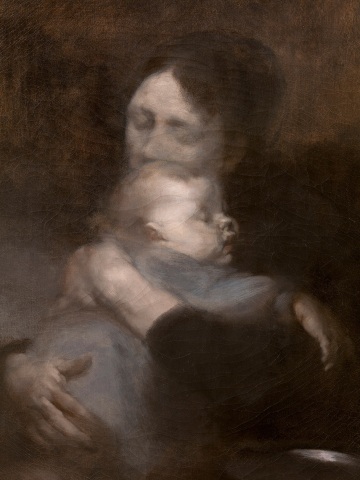Further images
Eugène Carrière’s work was rediscovered about thirty years ago. Though highly successful during his lifetime, his art fell into obscurity throughout the twentieth century. Today, he is recognised as one of the most significant French artists of the late nineteenth century and occupies an important place in fin-de-siècle Symbolism, which emerged in the visual arts from the mid-1880s. The poetic, dreamlike reverie that pervades his work particularly resonated with Symbolist critics such as Charles Morice and Jean Dolent, the latter describing Carrière’s art as 'reality having the magic of dreams'.
A close friend of Auguste Rodin, Carrière developed a distinctive, ethereal style—his often monochromatic, softly blurred compositions heighten the emotional depth of his chiaroscuro scenes. This evocative approach likely influenced Pablo Picasso’s Blue Period, shaping its melancholic introspection. Despite his connections to major artistic movements, Carrière remains difficult to categorise: he was not strictly a Symbolist, not fully aligned with Rodin, and neither a Fauvist nor a Cubist. Instead, he was a transitional figure, a bridge between the eras of Turner and Picasso, whose work captures the contrasting artistic impulses of the late nineteenth century.
Carrière’s legacy extends beyond his paintings. He founded the Académie Carrière, where he mentored young artists, including Henri Matisse, and influenced Picasso’s early work. Yet his own artistic vision remained distinct, shaped by his unique inspirations and personal aesthetic. Perhaps Carrière is so often overlooked because he defies easy classification. His work, however, endures—not only for its timeless beauty but also for the insight it offers into the evolving artistic landscape of the late nineteenth century.
Paul Sébastien Gallimard (20 July 1850 – 9 March 1929) was a French art collector, bibliophile, and theatre owner, and the father of publisher Gaston Gallimard.
In 1888, he commissioned a group portrait of his children from Eugène Carrière, who also created a portrait of Paul Gallimard with the inscription "À mon bon ami Paul Gallimard" ("For my good friend Paul Gallimard"). Carrière also painted Gallimard's wife, Lucie, who later posed for Pierre-Auguste Renoir in 1892. Gallimard’s art collection included 16 works by Renoir, as well as pieces by Edgar Degas, Berthe Morisot, Claude Monet, and Édouard Manet. He was a significant patron of the Impressionist movement and supported Renoir financially, even inviting him on a month-long trip to Madrid in 1892. Gallimard’s collection, comprising over 100 works, also featured pieces by masters such as Rembrandt, El Greco, Goya, Daumier, Corot, Ingres, Delacroix, and Millet. In addition, he acquired works by modern artists including Toulouse-Lautrec, Vuillard, Bonnard, Matisse, and Picasso. The significance of Gallimard's collection was recognised in 1908 by art critic Louis Vauxcelles in Les Arts. After Gallimard's death, his collection was sold by his heirs.
The present work was included in the monographic exhibition of Carrière's work held in Buenos Aires, Argentina, in 1936.
Provenance
Paul Gallimard (1850-1929), Paris, France
Maria J. de Pradize, Buenos Aires, Argentina
Exhibitions
Paris, Salon d'Automne, 1906, no. 32;
Paris, Ecole nationale des Beaux-Arts, Exposition de l'œuvre d'Eugène Carrière, 1907, no. 33;
Buenos Aires, Museo Nacional de Bellas Artes, Exposición de las obras de Eugène Carrière, 1936, no. 33
Literature
G. Denoinville, 'Eugène Carrière', in Revue populaire des beaux-Arts, no. 13, 1st April 1899, p. 199;
G. Séailles, Eugène Carrière, l'homme et l'artiste, Paris 1901, p. 70;
P. Jamot, 'Le Salon d'Automne', in Gazette des Beaux-Arts, June 1906, pp. 461-462;
A. Fontainas, 'Eugène Carrière à l'Ecole des Beaux-Arts', in L'Art moderne, 19 May 1907, p. 157;
Anonyme, 'Eugène Carrière : une exposition, un livre', dans La Grande Revue, May 1907, p. 714;
E. Faure, Eugène Carrière, peintre et lithographe, Paris 1908, p. 52 (repr.);
G. Séailles, Eugène Carrière : essai de biographie psychologique, Paris 1911, p. 80, no. 30;
J.-P. Dubray, Eugène Carrière. Essai critique, Paris 1931, pp. 25-26;
A.-M. Berryer, Eugène Carrière ; sa vie, son œuvre, sa philosophie, son enseignement ; suivi du catalogue de ses peintures, mémoire de doctorat de l'université de Bruxelles, Liege 1935, no. 66, fig. p. IV A;
V. Nora-Milin, Eugène Carrière 1849-1906, catalogue raisonné de l'œuvre peint, Paris 2008, p. 126, no. 285.





